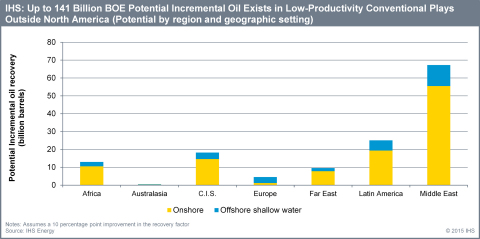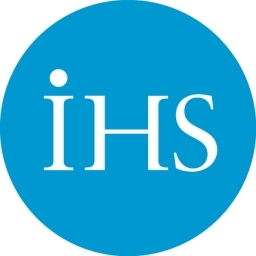HOUSTON--(BUSINESS WIRE)--As much as 141 billion barrels of potential incremental hydrocarbon resources could be unlocked if drilling and completion techniques refined in U.S. shale plays are applied to conventional, low-productivity oil plays outside of North America, according to new analysis from IHS (NYSE: IHS), the leading global source of critical information and insight.
Curious as to what the potential might be if newer techniques were applied to old plays, IHS Energy researchers conducted a high-level assessment that identified more than 170 mature oil plays worldwide with untapped oil potential that might benefit from horizontal drilling and hydraulic fracturing.
“While our analysis was an initial, high-level assessment of low productivity plays outside the U.S., we were quite surprised at the impressive potential for increased recovery using these unconventional techniques,” said Susan Farrell, vice president of upstream energy research at IHS, and one of the authors of the IHS analysis. “As many of the world’s oil and gas producers struggle to lower costs and optimize existing assets, we wondered what kind of impact the application of newer technological innovations could deliver to the industry in terms of expanding conventional resource potential outside North America.”
The rock properties in these mature plays are less than desirable for production using conventional techniques, and as a result, many of them have produced only a small portion of the total oil in place. Of the estimated 141 billion barrels of potentially recoverable oil using unconventional techniques, the IHS assessment determined that 135 billion of those barrels exist in plays that would likely require hydraulic fracture stimulation to produce, while approximately 6 billion barrels sit in plays that may not require hydraulic fracturing.
“Drilling horizontal wells allows access to thinner zones, where vertical wells are not commercially productive,” said Leta K. Smith, Ph.D., director of upstream energy research at IHS Energy, and the principal analyst behind the IHS analysis. “Also, horizontal wells allow engineers to connect compartmentalized portions of the reservoir with one well instead of many vertical wells, which addresses cost and footprint considerations as well as increasing the well-to-reservoir contact ratio.”
In addition, the study said, modern seismic and measurement-while-drilling (MWD) technologies would allow operators to achieve better placement of fractures to take advantage of natural fracturing and other geologic features for maximizing production and avoiding water zones. “Combined with other technologies developed for shale development, such as pad drilling, these improvements could breathe new life into some of these older, conventional fields,” Smith said.
Three recent examples were cited in the IHS analysis that showed operators already leveraging some of these newer techniques to address different geologic and production challenges. They included the Saint Martin de Bossenay field in the Paris (France) basin; the Tahe Complex in China’s Tarim basin, and the Bir Ben Tartar field in Tunisia.
The Saint Martin de Bossenay field was first discovered in 1959. By 1996, the field’s wells produced mostly water and it was abandoned. Recently, the field was redeveloped using modern technology, including seismic specifically targeting non-produced portions of the field. Hydraulic fracturing was not used, since it is not permitted in France. Following redevelopment, the field’s recovery factor improved from 40 percent to 44 percent--adding 1 million barrels to the 2P (proven plus probable reserves).
According to the IHS analysis, the numbers of low-productivity conventional fields that could benefit from new technologies are relatively evenly distributed across the various regions of the world, but two-thirds of the estimated potential incremental oil volumes are in the Middle East and Latin American countries. The top four countries outside of North America for potential incremental oil recovery in low-productivity conventional plays include Iran, Russia, Mexico and China.
While many of the top-15 countries identified as potential for increased production are access-limited for international oil companies, Mexico, in third-place, holds substantial incremental oil. With the upcoming opening of the country’s upstream sector, Smith said, Mexico may see new investment in these types of resources. “For operators with experience in these drilling and completion techniques,” she said, “Mexico may be an attractive option for future investment, along with some of the 14 countries identified outside the Middle East, including Brazil, the U.K., Norway, Congo and Indonesia.”
IHS Energy will be presenting at the 77th EAGE Conference and Exhibition 2015 in Madrid, June 1-4, booth number 331. To speak with Susan Farrell or Leta Smith regarding the IHS Energy Analysis of The Use of Unconventional Drilling and Completion Techniques in Conventional, Low-Quality Oil Fields Outside of North America, please contact Melissa Manning at melissa.manning@ihs.com. For more information on the IHS Energy analysis or the IHS Energy Upstream Industry Future service, please contact javan.meinwald@ihs.com.
About IHS (www.ihs.com)
IHS (NYSE: IHS) is the leading source of information, insight and analytics in critical areas that shape today’s business landscape. Businesses and governments in more than 165 countries around the globe rely on the comprehensive content, expert independent analysis and flexible delivery methods of IHS to make high-impact decisions and develop strategies with speed and confidence. IHS has been in business since 1959 and became a publicly traded company on the New York Stock Exchange in 2005. Headquartered in Englewood, Colorado, USA, IHS is committed to sustainable, profitable growth and employs more than 8,800 people in 32 countries around the world.
IHS is a registered trademark of IHS Inc. All other company and product names may be trademarks of their respective owners. © 2015 IHS Inc. All rights reserved.




